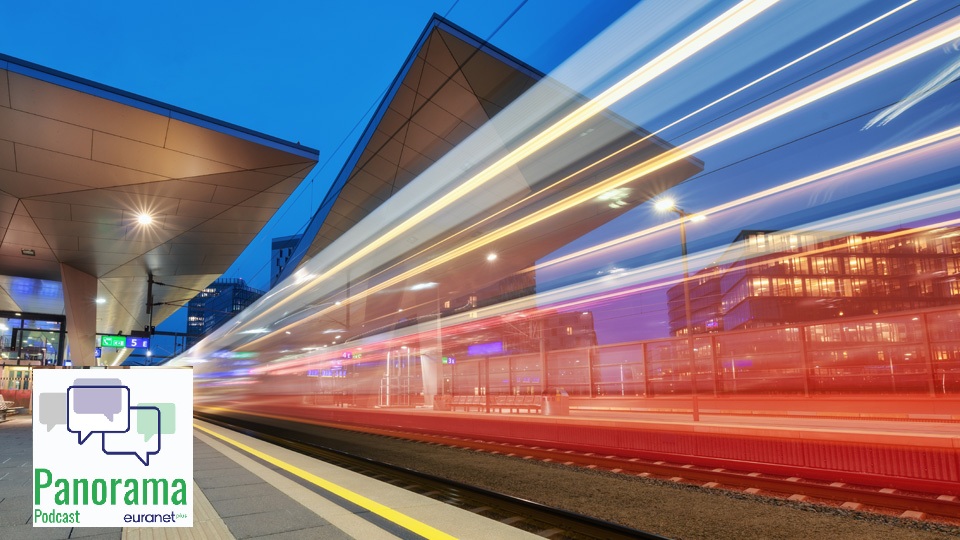Panorama 19.09.2025
Brussels is on the brink of unveiling a new strategy for a high-speed rail network connecting major cities right across the EU. In other news, Europe’s eastern flank has experienced multiple Russian drone incursions.

Radio România Internațional, 22.09.2025, 18:56
Brussels is on the brink of unveiling a new strategy for a high-speed rail network connecting major cities right across the EU. In other news, Europe’s eastern flank has experienced multiple Russian drone incursions.
The Commission’s rail initiative will build on its Sustainable and Smart Mobility Strategy and help the bloc to achieve its transport emission reduction targets. Ultimately, the idea is that trains should replace planes for the majority of short- and medium-haul passenger journeys around Europe.
Chugging along?
As things currently stand, Europe’s high-speed rail network remains fragmented along national borders, with different line gauges, rolling stock specifications, operating technologies and signalling systems complicating cross-border links. This contributes to it being far clunkier, more expensive and, critically, slower than it needs to be.
Carlos Fernandes is the vice-president of IP, the company that manages Portugal’s railway infrastructure. He gives a succinct summary of why speed matters so much if we are collectively to move away from the more polluting air travel. His comments are shared by Radio Renascença.
Carlos Fernandes, Vice-President of Infraestruturas de Portugal (in Portuguese):
“Trains clearly compete with aeroplanes for journeys of up to three hours or so. In this case, we undoubtedly beat air travel. Between three and six hours, the train’s competitiveness begins to diminish rapidly… and beyond six hours, planes are, to all intents and purposes, totally dominant.”
But we should not be under-ambitious, says the Community of European Railway and Infrastructure Companies. With the right investment and political commitment, high-speed rail could even carry over half of Europe’s long-haul passengers by 2070.
Fernandes goes on to outline the start-to-finish process for Portugal’s first high-speed line, which he suggests could be operational in as little as five years.
Carlos Fernandes, Vice-President of Infraestruturas de Portugal (in Portuguese):
“We will get started on the studies and plans. These will take 12 months or so. Before they are quite complete, we will begin expropriating the land. Before this, as part of the planning phase, we must also provide a recap, including confirmation of the route, to the Environment Agency, so that we can then move ahead with the expropriations. Then there’s a construction period of around 48 months. So, this all adds up to more than 60 months before a route can enter operation.”
While he mentions the “expropriations” very much as a formality, Renascença recently looked at the case of Vila Nova de Gaia, a city that abuts Porto and is the hub of the port wine industry. The high-speed line due to pass through here will necessitate the demolition of around 100 properties across the municipality, with others likely to suffer damage during the construction work.
Our Portuguese colleagues spoke to a number of local residents, one of whom is Cândida Carvalho. She highlights the human side of these expropriations.
Cândida Carvalho, Affected Resident (in Portuguese):
“We went to a meeting at the Parish Council offices, but with a technician representing a consultancy firm working on the high-speed rail project, and there, calmly, he told us that we are not on the route, but in the danger zone, in the construction zone. We were contacted because our house is going to be assessed. We are just a few metres from where the line will actually pass and our house may suffer damage and lose value due to the works. This is why we were contacted. […] I have only spoken to one of my neighbours so far and he is in a state of shock. He asks how this is possible. He built his house himself many years ago and is very emotionally attached to it. He is very upset.”
So perhaps the rail executive’s five-year estimate is a little ambitious after all.
Austria puts its money where its mouth is
On 14 December, a new high-speed railway line will open for business in Austria. It will connect two federal state capitals: Klagenfurt in Carinthia and Graz in Styria. The travel time on this important route will be cut to just 40 minutes – as opposed to 1 hour and 40 minutes by car.
Although this is first and foremost of benefit to Austrians living and working in these neighbouring regions, it also marks an important development at a European level, as the governor of Carinthia, Peter Kaiser, told our colleagues at Agora this week.
Peter Kaiser, Governor of Carinthia (in German):
“The international dimension, which is part of the Baltic-Adriatic axis, is enormous. We are actually connecting regions from Poland to Italy, and we are doing so through sustainable rail transport. […] Throughout history, railways have repeatedly brought about settlements and connections between people. This will also be the case here in the third millennium.”
Ionuț Săvoiu, the secretary of state at the Romanian Ministry of Transport and Infrastructure, agrees, as he tells Radio România.
Ionuț Săvoiu, Romania’s Deputy Minister of Transport (in Romanian):
“The high-speed rail project is fundamentally a cross-border project. So we have been aware from the outset that it must take us beyond the Romanian border. Because Vienna is about 1000 km away, Budapest some 700 to 800 km. So it is a project that must include a strong partnership between European countries. We must even look at developing routes in southern Romania. Perhaps to Athens or Istanbul, major urban agglomerations that can serve to attract the travelling public to the high-speed train system.”
Yet, while high-speed rail is very much on Romania’s radar for the future, Bucharest is currently focused on bringing its key main lines up to interoperability standards, Săvoiu explains. He suggests that it will probably be a good 10 to 15 years before any high-speed lines are up and running in the country.
The secretary of state holds out hope that the Commission’s initiative will ensure some level of pan-European coordination, helping all member states to work together to achieve this goal.
Ionuț Săvoiu, Romania’s Deputy Minister of Transport (in Romanian):
“The EU has consolidated its opinion within the Commission. There is the intention of taking concrete action to achieve a master plan at European level that would ensure member states are sufficiently integrated for these projects to develop in a coordinated manner, with a unitary concept ensuring connections between the main European cities.”
This is particularly important for Eastern Europe, he adds.
Ionuț Săvoiu, Romania’s Deputy Minister of Transport (in Romanian):
“All European countries are concerned about this issue, but especially those in Eastern Europe, where there is a development gap compared to Western countries such as France, Germany or Spain, which have had high-speed trains for perhaps 30 years. I believe that together we can find solutions and that, in the future, Romania will also have such a means of transport.”
Full steam ahead
With the Commission expected to present its delayed draft strategy next month, we have asked Björn Bender, CEO of pan-European ticketing agent Rail Europe, what he is hoping to see in it.
Bender confirms that ambition is not lacking, and what matters now is delivery, before listing a few points that he will be keeping a close eye on.
Björn Bender, CEO of Rail Europe (in English):
“So, cross-border connectivity, of course. We must prioritise the bottlenecks at borders and time-to-delivery on flagship projects like the Alpine Tunnels or even Rail Baltica. So the big corridor upgrades, because here the travellers will feel the difference first. And of course, it needs to be doable on the operational side in practice. So we need to have commitments that we really [achieve] a minimum passenger speed of around 160 km/h. We need binding timelines so rolling stock can really roam and connections align. And of course, the standards on infrastructure are great, but they need to have an enforcement.”
And what about funding, given that cash-strapped national operators will always put domestic services first?
Björn Bender, CEO of Rail Europe (in English):
“The funding needs to be realistic. So yes, we need to have funding throughout Europe, starting with the European Union, but also on the national side, including private capital at one point, and it needs to be dedicated finance, corridor by corridor.”
A Community of European Railway and Infrastructure Companies survey published in July suggests that three in four EU citizens would prefer to take a high-speed train instead of a plane if connections between capitals and major urban centres were fast and reliable. But not only that, adds Bender: bookings need to be simple and affordable too.
Björn Bender, CEO of Rail Europe (in English):
“We know that trains emit five to six times less carbon per passenger kilometre than planes, but travellers will only switch if it’s easy to find, book, and also afford. So that’s where distribution through platforms like ours turns infrastructure into a real actual model shift.”
Drone drama
Meanwhile, Europe’s eastern flank has been subject to multiple Russian drone incursions.
In May, the Council approved a financial instrument known as SAFE, which will boost loans to member states for defence, with investment in drones and anti-drone systems one of the areas given priority weighting.
And EU defence commissioner Andrius Kubilius has recently returned from a tour of the so-called ‘frontline states’, travelling from Finland to Bulgaria. He stresses that all these countries are very keen to develop joint capabilities – an initiative dubbed the Eastern Shield, which would include drone walls. So, Lithuania’s Žinių Radijas asks him, what next?
Andrius Kubilius, European Commissioner for Defence (in Lithuanian):
“We will begin to discuss in very concrete terms what we need to do next to develop the entire border, starting with the ability to see or hear drones flying in, because we do not currently have that capability. We are losing drones flying into Lithuania. Again, this involves radars, acoustic sensors and various other tools.”
But surely this is a national concern rather than an EU one, isn’t it?
Andrius Kubilius, European Commissioner for Defence (in Lithuanian):
“We see this as an important project, as a common European project, because countries need to develop their anti-drone capabilities not only to defend their own territories, but also to defend the entire European Union. This is to prevent such drones or any Russian aggression from reaching deeper into European territory. This is where European solidarity is important.”
But Captain Vasil Danov, a board member at the Atlantic Council of Bulgaria, a pro-European NGO, believes that this solidarity is exactly what Moscow is planning to put to the test – and before too long. He is speaking to BNR.
Vasil Danov, Board Member at the Atlantic Council of Bulgaria (in Bulgarian):
“Putin and his military leaders, his generals, will try to test NATO unity by attacking a small country. This will be [one of] the three Baltic states. Or us too, although they would have to go through Romania or make a landing through the Black Sea… but this is quite viable. And these small countries can’t handle a huge Russian army on their own.”
But as EU member states, they won’t be on their own – right?
Vasil Danov, Board Member at the Atlantic Council of Bulgaria (in Bulgarian):
“But yet again, there will be someone who will say, ‘I don’t know where these countries are on the map; who these Lithuanians, Latvians, Estonians are… We from Spain, for example, are not going to send people to die for these small countries’. [Russia] is counting on this kind of psychological breakthrough, followed by political and military ones.”
Which brings us back to the need for closer links between member states. How about a high-speed rail network, perhaps?






























